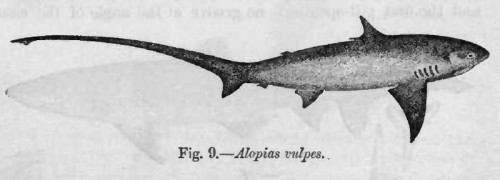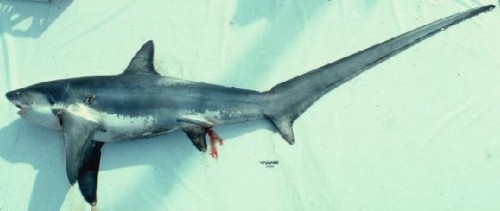Common Thresher
Thresher sharks can be found in almost every part of the temperate and tropical ocean and there are three type of the same species altogether. The most common thresher shark is also the largest of its species as it can attain up to six meters of length and half of its length is mainly of the elongated upper lobe of its caudal fin which is the most distinctive feature. Its body is built almost like a torpedo-shaped. The common thresher shark has a small body and broad head with relatively small sets of teeth as compared to the common shark.
Common thresher sharks are popularly known as strong and fast swimmer in the open sea. However because common thresher sharks are migratory creatures, they are unable to protect their eyes and brain from warm temperature as they lack an orbital rete mirables. Young common threshers tend to fall victims to larger sharks because of their small size. The normal diet of the common thresher shark is small school of forage fishes like mackerel, bluefish, herring and needlefish. Many stated that thresher shark would whip their elongated tail to stun their prey and whip it into their mouth. However, fish that was not consume after the whipping would be thrown at a very long distance away.
Common thresher sharks are oviviparious which means when they reproduce it will produce embryos inside an egg and the eggs will be retained by the mother until it hatched. Commonly, the thresher shark would produce four to seven pups each time, depending on its coastal region. They’ll produce less in cold regions. Newborn thresher shark pups grow up to 3 to 5 feet in length and the size of their growth differ depending on the population as well as the length of its mother.
Despite being a shark, common thresher sharks are not as dangerous to human as many others of shark species. However, their powerful tail could break even an adult’s bones in a single whip. Many reported that thresher sharks are shy and reserve creatures and they are also difficult to approach however, they should be treated with cautious and respect as any sign of threat from humans would be resulted in the thresher shark acting aggressively. Although many had reported that the common thresher shark’s tail could decapitate a human’s head, many others argue that such incident is impossible.
Somewhere in California in the United States, a reservation fishery that captivates all three thresher sharks species since 2007. It was built due to the rapid collapsed of the thresher sharks population. It was reported that recreational fishing for thresher sharks are the common cause for the decreasing rate of the sharks in the open ocean. Fishing for thresher sharks is known to be a sport in North America as they are one of the large sea predators that are easily captured as compared to other sea predators like common sharks and whales. Another cause known to have associated with the decreasing number of the thresher sharks is the overfishing in the region where the thresher sharks populates.




